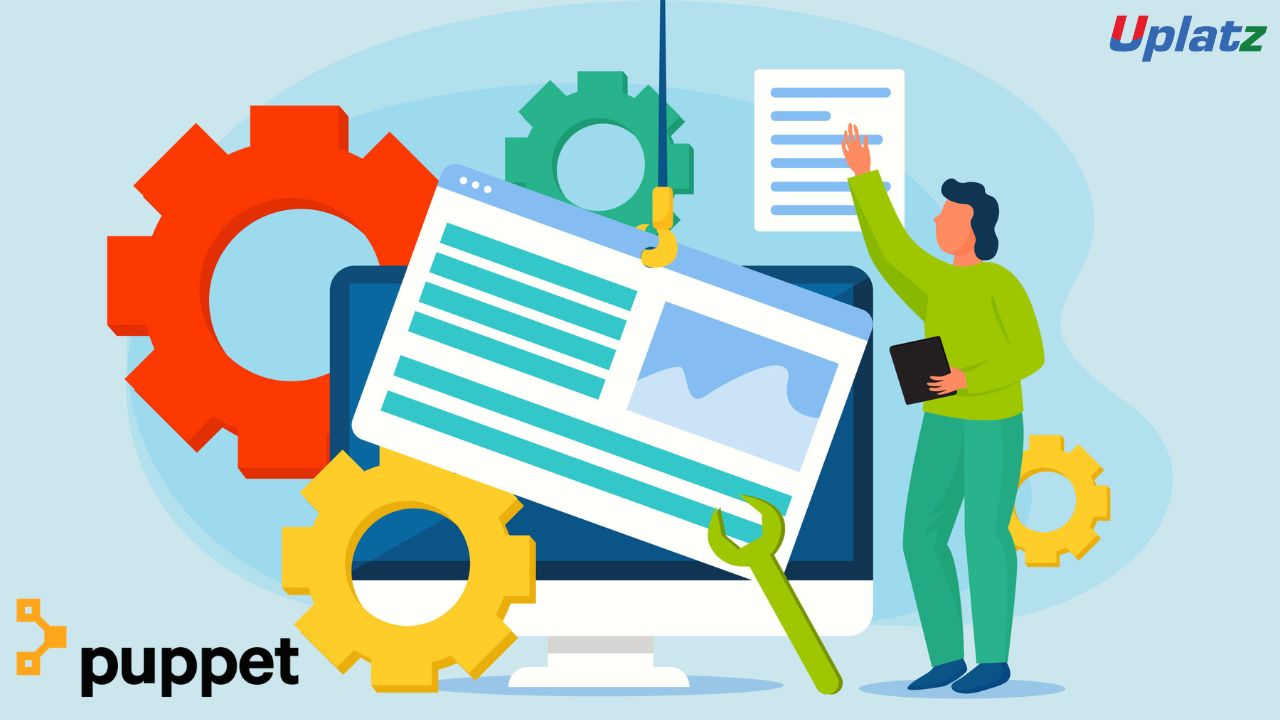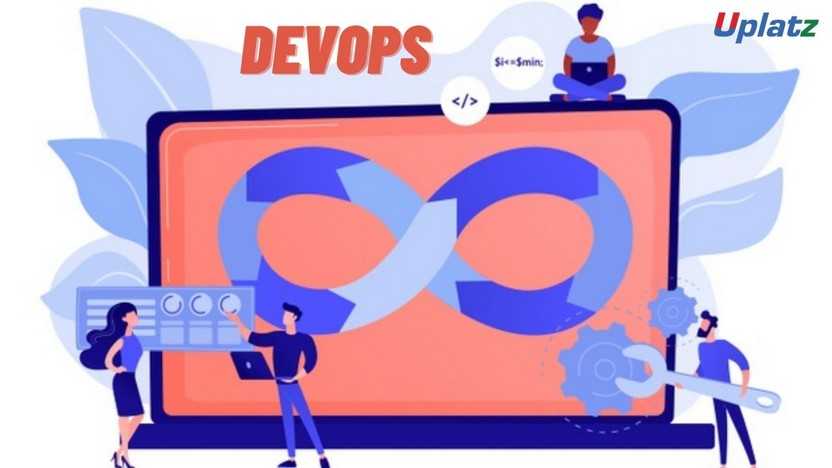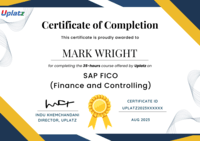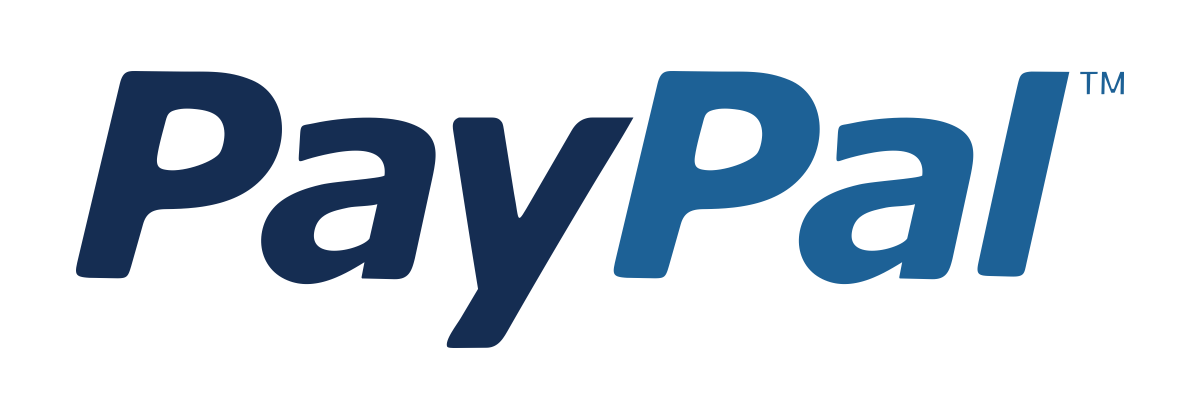Chef - Automate Infrastructure with Configuration as Code
Master Chef from scratch and automate your infrastructure, configurations, and server provisioning using code-driven DevOps workflows.
Course Duration: 10 Hours
Preview Chef - Automate Infrastructure with Configuration as Code course
Price Match Guarantee Full Lifetime Access Access on any Device Technical Support Secure Checkout Course Completion Certificate 92% Started a new career
BUY THIS COURSE (
92% Started a new career
BUY THIS COURSE (GBP 12 GBP 29 )-
 81% Got a pay increase and promotion
81% Got a pay increase and promotion
Popular
Trending
Job-oriented
Coming soon (2026)
Students also bought -
-

- Puppet: Automating Infrastructure Configuration at Scale
- 10 Hours
- GBP 12
- 10 Learners
-

- Ansible
- 10 Hours
- GBP 12
- 10 Learners
-

- DevOps
- 20 Hours
- GBP 12
- 1677 Learners

Chef - Automate Infrastructure with Configuration as Code – Online Course
Chef is a detailed, hands-on course crafted for DevOps professionals, systems administrators, and infrastructure engineers aiming to automate IT operations and enforce consistency across their server environments. Chef, a powerful configuration management tool, enables users to define infrastructure as code (IaC), making manual processes repeatable, scalable, and error-free.
Chef uses a Ruby-based domain-specific language (DSL) to write “recipes” that describe how servers should be configured, what software packages should be installed, how services should be started, and how files should be managed. These recipes are bundled into “cookbooks” that form the core of Chef's automation model. Chef works on a client-server architecture or in standalone mode with Chef Solo or Chef Zero, allowing flexibility in implementation.
What sets Chef apart from other configuration management tools is its declarative and testable approach to infrastructure. With Chef, you write code that describes the desired state of your system, and Chef ensures that this state is applied consistently every time—across staging, testing, and production environments.
In this course, you will learn how to:
- Set up and install Chef Development Kit (ChefDK)
- Write Chef cookbooks and recipes using best practices
- Use resources like package, service, template, and file for system configurations
- Manage node configurations using Chef client and server
- Use knife to manage nodes, environments, and data bags
- Test cookbooks using Test Kitchen, InSpec, and ChefSpec
- Automate configurations for multi-node setups and cloud environments (AWS, Azure)
- Integrate Chef with CI/CD pipelines using Jenkins or GitLab
The course begins with the fundamentals of infrastructure automation and the role of configuration management. From there, you’ll dive into the Chef ecosystem—Chef Server, Chef Workstation, Chef Infra Client—and explore how to write, test, and deploy infrastructure code.
You’ll also build real-world automation projects like:
- Provisioning and configuring a LAMP stack
- Automating user account creation and SSH key distribution
- Managing environment-specific configurations
- Using data bags to handle dynamic configuration data
- Deploying web applications with load balancers and monitoring tools
Chef promotes DevOps principles by reducing human error, enforcing consistency, speeding up deployments, and allowing collaboration through version-controlled infrastructure. This course prepares you not just to use Chef, but to understand its ecosystem, design patterns, and best practices so you can confidently manage infrastructure in complex environments.
Whether you're running 5 servers or 5000, Chef makes it easy to enforce consistent states, roll back changes, and handle system drift.
Who this course is for:
- DevOps Engineers aiming to manage infrastructure at scale
- System Administrators transitioning to automation roles
- Infrastructure Engineers deploying services across hybrid or cloud setups
- Developers seeking Infrastructure as Code (IaC) skills
- Beginners looking to enter the DevOps space with real, enterprise-grade tooling
This course goes beyond the “how” and into the “why” of infrastructure automation. With Chef, you're not just scripting—you're engineering. By mastering Chef, you gain one of the most in-demand skills in modern infrastructure management.
Course/Topic 1 - Coming Soon
-
The videos for this course are being recorded freshly and should be available in a few days. Please contact info@uplatz.com to know the exact date of the release of this course.
Course Objectives Back to Top
By the end of this course, you will be able to:
- Understand the architecture and components of Chef (Workstation, Server, Client)
- Write Chef cookbooks and recipes using Ruby DSL
- Automate software installations, service configurations, and user management
- Use knife to interact with nodes, environments, and data bags
- Apply test-driven development (TDD) using ChefSpec and InSpec
- Deploy configurations across local, on-prem, or cloud environments
- Implement idempotent and version-controlled infrastructure as code
- Integrate Chef into CI/CD pipelines and DevOps workflows
Course Syllabus Back to Top
Chef Course Syllabus
Module 1: Introduction to Chef and Configuration Management
- What is Configuration Management?
- Chef vs Ansible vs Puppet
- Chef Architecture and Components
Module 2: Installing Chef
- ChefDK and Chef Workstation
- Chef Client, Solo, and Server Setup
- Chef Zero and Local Mode
Module 3: Writing Recipes and Cookbooks
- Ruby DSL for Recipes
- Cookbooks, Metadata, Templates, and Files
- Executing Recipes on Nodes
Module 4: Resources and Attributes
- Built-in Resources (package, file, service, etc.)
- Custom Resources
- Node and Environment Attributes
Module 5: Managing Nodes and Environments
- Bootstrap Nodes with knife
- Roles and Environments
- Search and Data Bags
Module 6: Testing and Validation
- Test Kitchen Basics
- ChefSpec for Unit Testing
- InSpec for Compliance Testing
Module 7: Real-World Projects
- LAMP Stack Provisioning
- Monitoring Stack with Nagios
- Multi-node Application Deployment
Module 8: Chef in the Cloud
- Using Knife EC2 Plugin
- Automating AWS and Azure Environments
- Dynamic Inventory with Cloud Platforms
Module 9: CI/CD and DevOps Integration
- Chef + Jenkins Pipelines
- Git Workflow for Cookbook Development
- Release Management and Versioning
Module 10: Chef Interview Questions & Answers
- Top Questions with Best Practices
- Practical Automation Scenarios
- Debugging Techniques
Certification Back to Top
Upon successful completion, learners will receive a Certificate of Completion from Uplatz, validating their expertise in Chef automation and infrastructure-as-code. This certification demonstrates proficiency in writing Chef recipes and cookbooks, managing infrastructure environments, and integrating Chef into real-world DevOps pipelines. It boosts credibility when applying for roles in DevOps, infrastructure engineering, or cloud automation. The certificate reflects both theoretical mastery and hands-on experience—skills increasingly valued in today’s job market.
Career & Jobs Back to Top
Chef is widely used by large enterprises, especially those in finance, healthcare, and technology sectors that demand consistency, compliance, and automation at scale. Proficiency in Chef opens up roles such as:
- Infrastructure Automation Engineer
- DevOps Engineer
- Systems Configuration Engineer
- Site Reliability Engineer (SRE)
- Release Manager
As companies transition to cloud-native, microservice, and hybrid architectures, the demand for Chef specialists who can automate infrastructure safely and repeatably is on the rise. With Chef in your skill set, you’ll be equipped to lead automation efforts, enforce best practices, and contribute to robust DevOps strategies.
Interview Questions Back to Top
1. What is Chef and why is it used?
Chef is an automation platform that turns infrastructure into code. It is used to configure systems, deploy software, and manage servers in a scalable and repeatable manner.
Chef is an automation platform that turns infrastructure into code. It is used to configure systems, deploy software, and manage servers in a scalable and repeatable manner.
2. What are cookbooks and recipes in Chef?
A recipe is a file containing configurations written in Ruby. A cookbook is a collection of recipes and supporting files grouped by functionality.
A recipe is a file containing configurations written in Ruby. A cookbook is a collection of recipes and supporting files grouped by functionality.
3. How does Chef ensure idempotency?
Chef ensures idempotency by checking if a resource is already in the desired state before making any changes, preventing redundant operations.
Chef ensures idempotency by checking if a resource is already in the desired state before making any changes, preventing redundant operations.
4. What is the role of the knife tool?
knife is Chef's command-line tool used to manage cookbooks, bootstrap nodes, upload data bags, and interact with the Chef Server.
knife is Chef's command-line tool used to manage cookbooks, bootstrap nodes, upload data bags, and interact with the Chef Server.
5. What are attributes in Chef?
Attributes are key-value pairs used to define node-specific or environment-specific settings, influencing the behavior of recipes during execution.
Attributes are key-value pairs used to define node-specific or environment-specific settings, influencing the behavior of recipes during execution.
6. What is a data bag?
A data bag is a global variable store in JSON format used to share data across nodes, such as passwords or API keys.
A data bag is a global variable store in JSON format used to share data across nodes, such as passwords or API keys.
7. How does Chef differ from Ansible?
Chef uses a pull-based model with a client-server architecture and Ruby DSL, while Ansible uses YAML and a push-based model with no agents.
Chef uses a pull-based model with a client-server architecture and Ruby DSL, while Ansible uses YAML and a push-based model with no agents.
8. What is Test Kitchen?
Test Kitchen is a tool used to test Chef cookbooks on different platforms and environments using virtualization or containers.
Test Kitchen is a tool used to test Chef cookbooks on different platforms and environments using virtualization or containers.
9. Can Chef be used for cloud provisioning?
Yes, Chef supports cloud provisioning using plugins like knife-ec2, knife-azure, and integrations with Terraform or AWS CloudFormation.
Yes, Chef supports cloud provisioning using plugins like knife-ec2, knife-azure, and integrations with Terraform or AWS CloudFormation.
10. How do you manage secrets in Chef?
Secrets are typically managed using encrypted data bags or external vault integrations like HashiCorp Vault or Chef Vault.
Secrets are typically managed using encrypted data bags or external vault integrations like HashiCorp Vault or Chef Vault.
Course Quiz Back to Top
FAQs
Back to Top
Q1. What are the payment options?
A1. We have multiple payment options:
1) Book your course on our webiste by clicking on Buy this course button on top right of this course page
2) Pay via Invoice using any credit or debit card
3) Pay to our UK or India bank account
4) If your HR or employer is making the payment, then we can send them an invoice to pay.
Q2. Will I get certificate?
A2. Yes, you will receive course completion certificate from Uplatz confirming that you have completed this course with Uplatz. Once you complete your learning please submit this for to request for your certificate https://training.uplatz.com/certificate-request.php
Q3. How long is the course access?
A3. All our video courses comes with lifetime access. Once you purchase a video course with Uplatz you have lifetime access to the course i.e. forever. You can access your course any time via our website and/or mobile app and learn at your own convenience.
Q4. Are the videos downloadable?
A4. Video courses cannot be downloaded, but you have lifetime access to any video course you purchase on our website. You will be able to play the videos on our our website and mobile app.
Q5. Do you take exam? Do I need to pass exam? How to book exam?
A5. We do not take exam as part of the our training programs whether it is video course or live online class. These courses are professional courses and are offered to upskill and move on in the career ladder. However if there is an associated exam to the subject you are learning with us then you need to contact the relevant examination authority for booking your exam.
Q6. Can I get study material with the course?
A6. The study material might or might not be available for this course. Please note that though we strive to provide you the best materials but we cannot guarantee the exact study material that is mentioned anywhere within the lecture videos. Please submit study material request using the form https://training.uplatz.com/study-material-request.php
Q7. What is your refund policy?
A7. Please refer to our Refund policy mentioned on our website, here is the link to Uplatz refund policy https://training.uplatz.com/refund-and-cancellation-policy.php
Q8. Do you provide any discounts?
A8. We run promotions and discounts from time to time, we suggest you to register on our website so you can receive our emails related to promotions and offers.
Q9. What are overview courses?
A9. Overview courses are 1-2 hours short to help you decide if you want to go for the full course on that particular subject. Uplatz overview courses are either free or minimally charged such as GBP 1 / USD 2 / EUR 2 / INR 100
Q10. What are individual courses?
A10. Individual courses are simply our video courses available on Uplatz website and app across more than 300 technologies. Each course varies in duration from 5 hours uptop 150 hours.
Check all our courses here https://training.uplatz.com/online-it-courses.php?search=individual
Q11. What are bundle courses?
A11. Bundle courses offered by Uplatz are combo of 2 or more video courses. We have Bundle up the similar technologies together in Bundles so offer you better value in pricing and give you an enhaced learning experience.
Check all Bundle courses here https://training.uplatz.com/online-it-courses.php?search=bundle
Q12. What are Career Path programs?
A12. Career Path programs are our comprehensive learning package of video course. These are combined in a way by keeping in mind the career you would like to aim after doing career path program. Career path programs ranges from 100 hours to 600 hours and covers wide variety of courses for you to become an expert on those technologies.
Check all Career Path Programs here https://training.uplatz.com/online-it-courses.php?career_path_courses=done
Q13. What are Learning Path programs?
A13. Learning Path programs are dedicated courses designed by SAP professionals to start and enhance their career in an SAP domain. It covers from basic to advance level of all courses across each business function. These programs are available across SAP finance, SAP Logistics, SAP HR, SAP succcessfactors, SAP Technical, SAP Sales, SAP S/4HANA and many more
Check all Learning path here https://training.uplatz.com/online-it-courses.php?learning_path_courses=done
Q14. What are Premium Career tracks?
A14. Premium Career tracks are programs consisting of video courses that lead to skills required by C-suite executives such as CEO, CTO, CFO, and so on. These programs will help you gain knowledge and acumen to become a senior management executive.
Q15. How unlimited subscription works?
A15. Uplatz offers 2 types of unlimited subscription, Monthly and Yearly.
Our monthly subscription give you unlimited access to our more than 300 video courses with 6000 hours of learning content. The plan renews each month. Minimum committment is for 1 year, you can cancel anytime after 1 year of enrolment.
Our yearly subscription gives you unlimited access to our more than 300 video courses with 6000 hours of learning content. The plan renews every year. Minimum committment is for 1 year, you can cancel the plan anytime after 1 year.
Check our monthly and yearly subscription here https://training.uplatz.com/online-it-courses.php?search=subscription
Q16. Do you provide software access with video course?
A16. Software access can be purchased seperately at an additional cost. The cost varies from course to course but is generally in between GBP 20 to GBP 40 per month.
Q17. Does your course guarantee a job?
A17. Our course is designed to provide you with a solid foundation in the subject and equip you with valuable skills. While the course is a significant step toward your career goals, its important to note that the job market can vary, and some positions might require additional certifications or experience.
Remember that the job landscape is constantly evolving. We encourage you to continue learning and stay updated on industry trends even after completing the course. Many successful professionals combine formal education with ongoing self-improvement to excel in their careers. We are here to support you in your journey!
Q18. Do you provide placement services?
A18. While our course is designed to provide you with a comprehensive understanding of the subject, we currently do not offer placement services as part of the course package. Our main focus is on delivering high-quality education and equipping you with essential skills in this field.
However, we understand that finding job opportunities is a crucial aspect of your career journey. We recommend exploring various avenues to enhance your job search:
a) Career Counseling: Seek guidance from career counselors who can provide personalized advice and help you tailor your job search strategy.
b) Networking: Attend industry events, workshops, and conferences to build connections with professionals in your field. Networking can often lead to job referrals and valuable insights.
c) Online Professional Network: Leverage platforms like LinkedIn, a reputable online professional network, to explore job opportunities that resonate with your skills and interests.
d) Online Job Platforms: Investigate prominent online job platforms in your region and submit applications for suitable positions considering both your prior experience and the newly acquired knowledge. e.g in UK the major job platforms are Reed, Indeed, CV library, Total Jobs, Linkedin.
While we may not offer placement services, we are here to support you in other ways. If you have any questions about the industry, job search strategies, or interview preparation, please dont hesitate to reach out. Remember that taking an active role in your job search process can lead to valuable experiences and opportunities.
Q19. How do I enrol in Uplatz video courses?
A19. To enroll, click on "Buy This Course," You will see this option at the top of the page.
a) Choose your payment method.
b) Stripe for any Credit or debit card from anywhere in the world.
c) PayPal for payments via PayPal account.
d) Choose PayUmoney if you are based in India.
e) Start learning: After payment, your course will be added to your profile in the student dashboard under "Video Courses".
Q20. How do I access my course after payment?
A20. Once you have made the payment on our website, you can access your course by clicking on the "My Courses" option in the main menu or by navigating to your profile, then the student dashboard, and finally selecting "Video Courses".
Q21. Can I get help from a tutor if I have doubts while learning from a video course?
A21. Tutor support is not available for our video course. If you believe you require assistance from a tutor, we recommend considering our live class option. Please contact our team for the most up-to-date availability. The pricing for live classes typically begins at USD 999 and may vary.









